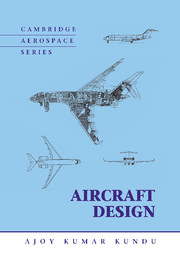Book contents
- Frontmatter
- Contents
- List of Symbols and Abbreviations
- Preface
- Road Map of the Book
- 1 Introduction
- 2 Methodology to Aircraft Design, Market Survey, and Airworthiness
- 3 Aerodynamic Considerations
- 4 Aircraft Classification, Statistics, and Choices for Configuration
- 5 Aircraft Load
- 6 Configuring Aircraft
- 7 Undercarriage
- 8 Aircraft Weight and Center of Gravity Estimation
- 9 Aircraft Drag
- 10 Aircraft Power Plant and Integration
- 11 Aircraft Sizing, Engine Matching, and Variant Derivative
- 12 Stability Considerations Affecting Aircraft Configuration
- 13 Aircraft Performance
- 14 Computational Fluid Dynamics
- 15 Miscellaneous Design Considerations
- 16 Aircraft Cost Considerations
- 17 Aircraft Manufacturing Considerations
- Appendix A Conversion
- Appendix B International Standard Atmosphere
- Appendix C Aerofoils
- Appendix D Case Studies
- Appendix E Tire Data
- References
- Index
8 - Aircraft Weight and Center of Gravity Estimation
Published online by Cambridge University Press: 05 June 2012
- Frontmatter
- Contents
- List of Symbols and Abbreviations
- Preface
- Road Map of the Book
- 1 Introduction
- 2 Methodology to Aircraft Design, Market Survey, and Airworthiness
- 3 Aerodynamic Considerations
- 4 Aircraft Classification, Statistics, and Choices for Configuration
- 5 Aircraft Load
- 6 Configuring Aircraft
- 7 Undercarriage
- 8 Aircraft Weight and Center of Gravity Estimation
- 9 Aircraft Drag
- 10 Aircraft Power Plant and Integration
- 11 Aircraft Sizing, Engine Matching, and Variant Derivative
- 12 Stability Considerations Affecting Aircraft Configuration
- 13 Aircraft Performance
- 14 Computational Fluid Dynamics
- 15 Miscellaneous Design Considerations
- 16 Aircraft Cost Considerations
- 17 Aircraft Manufacturing Considerations
- Appendix A Conversion
- Appendix B International Standard Atmosphere
- Appendix C Aerofoils
- Appendix D Case Studies
- Appendix E Tire Data
- References
- Index
Summary
Overview
An aircraft must ascend to heights by defying gravity and sustain the tiring task of cruise – naturally, it is weight-sensitive. Anyone who has climbed a hill knows about this experience, especially if one has to carry baggage. An inanimate aircraft is no exception; its performance suffers by carrying unnecessary mass (i.e., weight). At the conceptual design stage, aircraft designers have a daunting task of creating a structure not only at a low weight but also at a low cost, without sacrificing safety. Engineers also must be accurate in weight estimation, well ahead of manufacture. This chapter presents a formal method to predict an aircraft and its component mass (i.e., weight), which results in locating the CG during the conceptual design phase. The aircraft inertia estimation is not within the scope of this book.
In the past, aircraft weight was expressed in FPS units in pound (lb) weight in the United Kingdom and the United States. With the use of kg as mass in SI, the unit for weight is a Newton, which is calculated as the mass multiplied by gravitational acceleration (9.81 m/s2). This book uses both the FPS and SI systems; this chapter addresses mass in SI and weight in FPS, sometimes interchangeably.
Material strength contributes to structural integrity. As stated previously, aircraft conceptual designers must have broad-based knowledge in all aspects of technology; in this case, they must have a sound knowledge in material properties (e.g., strength-to-weight and strength-to-cost ratios).
- Type
- Chapter
- Information
- Aircraft Design , pp. 223 - 257Publisher: Cambridge University PressPrint publication year: 2010



